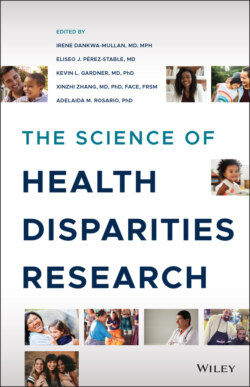Читать книгу The Science of Health Disparities Research - Группа авторов - Страница 34
2.4 Anticipatory Biology and Behavior: The Embedding of Exposures Across the Life Course
ОглавлениеThe life course perspective provides a useful framework to understand the dimensions of human behavior; that is, how chronological age, life transitions, and social and environmental contexts and changes shape human lives, behaviors, and health, from birth through the lifespan. The framework builds on evidence that lived experiences set people on trajectories that influence health and well‐being over the life course. Each of these experiences in time contribute to the health status so that repeated periods of stress, nutritional deficiency, and/or social deprivation beginning in utero and continuing through childhood and adult life set up a sequence of poor development at each stage. The cumulative stress or the accumulation of these deprivations over the lifespan can eventually manifest in poor health and premature death (Figure 2.1b). This is a biological imperative that persists throughout the life course and involves mechanisms in which the changes and sequelae of adaptation become “baked‐in” or “get under the skin” and accrue across the life course—and, in some cases, are transmitted trans‐generationally [3, 22].
This imperative and its impact on allostatic load are supported through many concepts that examine processes and mechanisms of adaptation. One concept originally proposed by Neel [23] and referred to as the “thrifty gene” concept purports that certain genes linked to metabolisms could have evolved in response to specific environmental conditions characterized by fluctuations in nutrient availability. Thus, genes and gene systems that are energy conserving would have selective advantage. A simple example provided by Power and Schulkin [24] would be the adaptation of the genetic pathways linked to metabolic energy conservation, storage, and adiposity that could have evolved in response to environments that were episodically exposed to periods of famine. Chronic use of these adaptive pathways in environmental conditions that are nutrient rich would thus predispose to an allostatic load, which would be reflected in metabolic imbalance, obesity, and diabetes [24].
The mechanisms underlying this type of adaptation or selection need not be restricted to Darwinian time scales, but could involve mechanisms that evolve in a developmental context through epigenetic regulation. A classic example is the cohort of individuals that were exposed to prenatal famine in the Dutch Hunger Winter of 1944–1945, and who later, in adulthood, experienced higher incidence of depression, schizophrenia, hyper‐responsiveness to stress, metabolic imbalance, and diabetes. This cohort was later found to show epigenetic alterations at genes important in controlling metabolism, including loss of imprinted deoxyribonucleic acid (DNA) methylation at the IGF2 gene [25]. Thus, the earliest of exposures became embedded across the life course at loci that were likely to influence disease risk decades later.
Mechanisms of epigenetic regulation are likely to have a pervasive influence on how traits and susceptibility become embedded and accrue across the life course [26]. Epigenetic changes and regulatory pathways regulating the hypothalamic expression of the fat mass and obesity‐associated gene (FTO), a regulator of food intake and energy balance, has been widely studied [27]. Exploration of epigenetic control of the genes governing pathways that regulate feeding, sleep, energy balance, and metabolism has only begun [22]. In this regard, GR and MR are nuclear receptors for glucocorticoids that influence a broad array of epigenetic regulatory events linked to changes in chromatin modification and DNA methylation. Thus, the stress response system is a prime target for the process in which its overuse can become stably embedded in the genome through alterations in epigenetic control.
Epigenetic biomarkers may reflect causative mechanisms or provide quantitative measures of cumulative biological influences of allostatic load. For example, studies are beginning to show that life's stressors accelerate aging, which can be reflected in DNA methylation patterns, some of which drive or reflect the aging phenotype [22]. In other instances, these stressors shorten telomeres found in peripheral blood lymphocytes, which have been significantly associated with allostatic load and impoverished neighborhood resources [28]. Changes that occur to chromatin with aging are a new, fast‐growing area of study [22].
